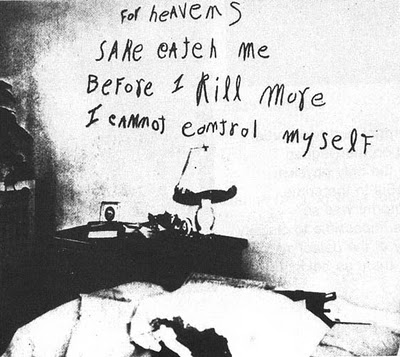
 |
||||||||||||||
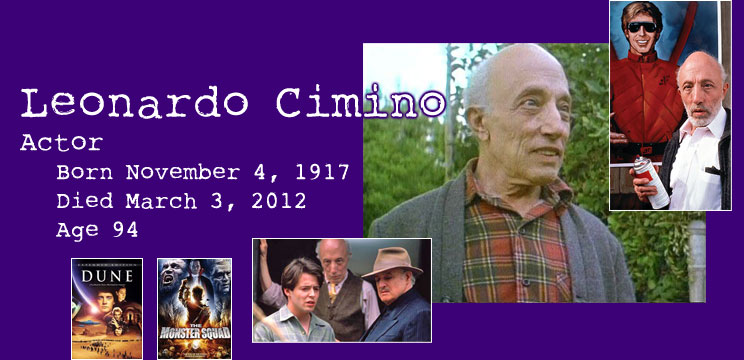 |
||||||||||||||
You had never heard of Leonardo Cimino before he died. You admit that freely. Oh, you saw him plenty. On TV, in the movies, even on the stage — but you'll be goddamned if you ever knew his name. You would surf around a hotel TV set streaming analog-only and there he would be with Kojak, playing someone named Ruby Kabelsky. Or you'd see him in Before the Devil Knows You're Dead and later you'd learn that he was one of Lumet's oldest friends. You may never have known there was nepotism in casting because you thought he really was a perfect rotten jeweler. Without knowing his name, you thought he was Jewish because he played Jewish very well. Then you'd swear he was a big-time Catholic because he played popes, cardinals and priests. Repeatedly. You instinctively knew he'd be good at murdering, conniving, mobbing up, because he always had that shifty, pointy-head sensibility. Oh, that guy! You'd say that occasionally. By that time, you'd made up a list of people known as character actors, people whose names you never knew until you decided to make up a list of character actors and play a deadpool with the list, and you put him at the top of that list because, really, how much longer could he last? And you called yourself B&T's Characters, and what do you know, you got a hit. His death at 94 gave you 7 points. (Five for the solo, two for the hit.) After that, you forgot about him. Until you turned on the TV one day and there he was again, in Waterworld, playing an elder, or The Monster Squad, playing Scary German Guy, or any one of a dozen New York-types in Naked City. (Maybe you were back in a hotel room without HD.) And you think, who are all these other character actors, and you start your list for the next year. And the year after that. You are good. — Amelia |
||||||||||||||
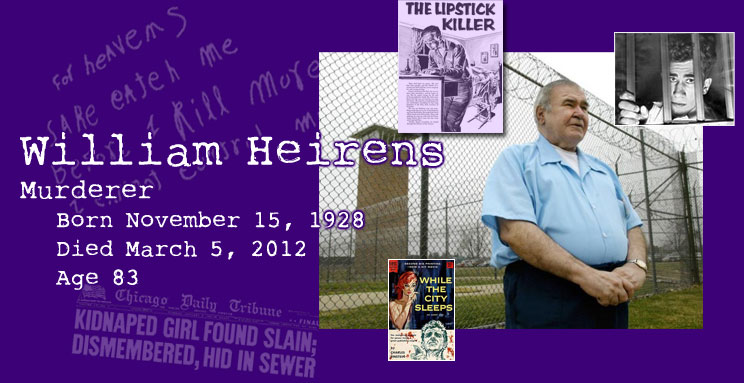 |
||||||||||||||
Hulka volunteered to write up his neat solo. I didn't know that that meant research above and beyond. I'm hoping that the book he was waiting for to finish writing it was from the library. I'd hate to think you guys are spending money on these updates. Wonderful job. Simply wonderful. * * * It is clear that, by the summer of 1946, William Heirens was a criminal creeper who needed to be stopped. A 17-year-old student in an advanced engineering program at the University of Chicago, Heirens was also a serial burglar who'd already done a three-year stretch in reform school for breaking and entering. Upon his release, he returned to his old habits, balancing his crimes and his studies with honest work as a movie-theater usher. He later claimed he stole for cheap thrills (sometimes, but not always, sexual) and to "relieve tension," not for money. It is not clear that William Heirens was the murderer who terrorized Chicago in 1945 and 1946, preying on young and old women alike and earning the tabloid nickname "Lipstick Killer" for the lipstick-scrawled note left on a victim's wall:
For that matter, it's not clear that all three of the murders attributed to the "Lipstick Killer" were the work of the same person. The circumstances and methods of the killings differed substantially, and the techniques of analysis that could conclusively attribute different crimes to a single culprit today weren't, for the most part, available to police then. The victims were all women or girls; they were all murdered in Chicago, within the same general time period; at the time, that was enough for the cops. The evidence against Heirens ranged from the merely circumstantial — he'd been caught breaking into an apartment not far from where the dismembered body of six-year-old Suzanne Degnan had been found — to the downright spurious, including fingerprint and handwriting "matches" that didn't meet even the imprecise standards of the era and a "confession" extracted over six days of police beatings and sodium pentothal injections (without the knowledge, let alone consent, of an attorney, since he wasn't allowed to consult one) and supplemented by details taken directly from the Chicago tabloids' lurid coverage of the murders. More than 50 years after the fact, a clemency petition from the Northwestern University Center on Wrongful Convictions alleged more "prosecutorial misconduct, incompetent defense counsel, unprecedented prejudicial pretrial publicity, junk science [...] and mistaken eyewitness identification than any other case we have studied." Nonetheless, Heirens pled guilty to three murders, in order to avoid a death sentence, and was sentenced to three consecutive life terms in prison. In one sense, Heirens' story ends there. The redemptive process that had served him well as a teenager, winning him acceptance to a prestigious university while he was still serving a reform-school sentence, was no help to him as an adult, stacked against the horrific crimes he'd been tried and convicted of. Although time and perspective revealed more and more damning weaknesses in the process that branded him the Lipstick Killer, and although, by the law at the time of his conviction, he should have been paroled by the mid-1980s, he spent the rest of his life in jail. A series of so-called "tough on crime" legislators, including future Chicago mayor Richard M. Daley, saw to that. At the time of his death, the first prisoner in Illinois history to complete a four-year college degree had been serving out his sentence in minimum-security prisons for 37 years, and it is alleged that he was the longest-serving prisoner in American history (though, given the American criminal justice system's recent fondness for treating children like adults, it's likely that this record will be broken in the near future). He was 83. Hulka, who enjoys referring to himself in the third person, gets 5 points for the hit and 5 more for the solo. — Hulka |
||||||||||||||
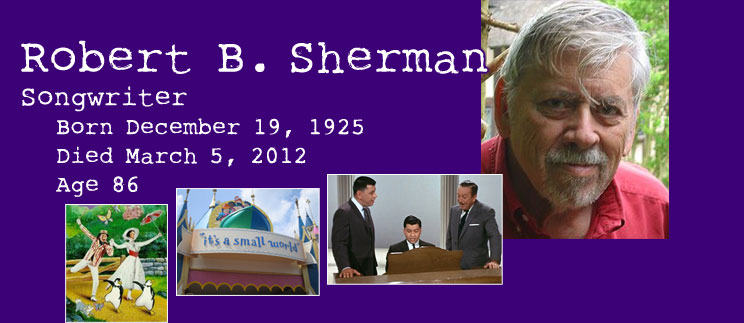 |
||||||||||||||
It's a small world after all. It's a small world after all. It's a small world after all. It's a small small world. It's a small world after all. It's a small world after all. It's a small world after all. It's a small small world. It's a small world after all. It's a small world after all. It's a small world after all. It's a small small world. It's a small world after all. It's a small world after all. It's a small world after all. It's a small small world. It's a small world after all. It's a small world after all. It's a small world after all. It's a small small world. It's a small world after all. It's a small world after all. It's a small world after all. It's a small small world. It's a small world after all. It's a small world after all. It's a small world after all. It's a small small world. It's a small world after all. It's a small world after all. It's a small world after all. It's a small small world. It's a small world after all. It's a small world after all. It's a small world after all. It's a small small world. It's a small world after all. It's a small world after all. It's a small world after all. It's a small small world. It's a small world after all. It's a small world after all. It's a small world after all. It's a small small world. It's a small world after all. It's a small world after all. It's a small world after all. It's a small small world. It's a small world after all. It's a small world after all. It's a small world after all. It's a small small world. It's a small world after all. It's a small world after all. It's a small world after all. It's a small small world. It's a small world after all. It's a small world after all. It's a small world after all. It's a small small world. You can thank RH Draney for this supercalifragilisticexpialidocious hit. 10 points. 5 + 5. — Amelia |
||||||||||||||
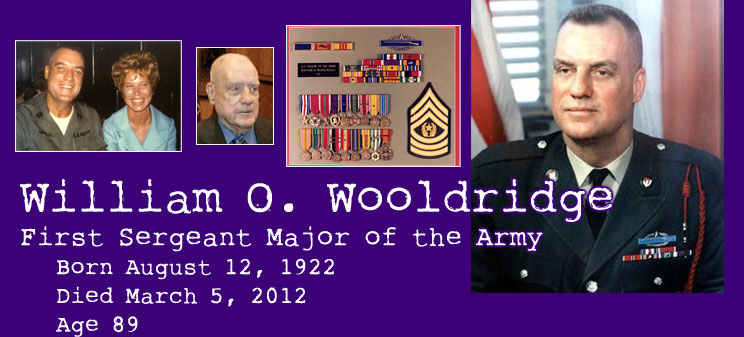 |
||||||||||||||
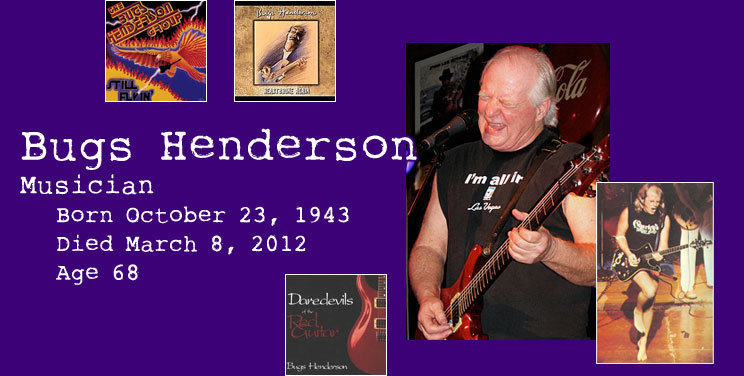 |
||||||||||||||
JD Baldwin got the hit and knew damn well none of us was going to write it up. So he did. Cool hit. * * * "Bugs" Henderson was a friend to, and frequent band member for, the likes of Muddy Waters, Stevie Ray Vaughn and BB King. I am a little chagrined to tell you that I knew who Bugs was mainly because I heard Ted Nugent talk about him on the radio around ten years ago. Ted, to his credit, idolized the man. Bugs had, they say, quite a following in Europe going back to the 1970s, but he never caught on over here. I guess that's why I know his name but couldn't name you a single one of his albums or even a track of his that ever got any airplay. I had a couple of mp3s of his, but I think they're on the old hard drive that I haven't transferred over to the new one yet. So I can't even go back and listen to them to re-form an impression to tell you about. Famous enough for the pool, obscure enough for a solo. My kind of hit: 11 + 5 == 16 points. — JD Baldwin |
||||||||||||||
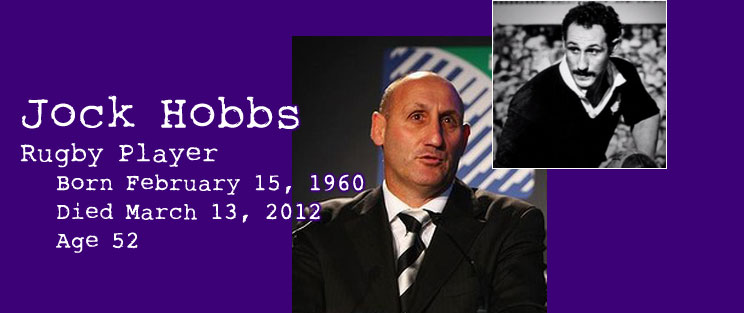 |
||||||||||||||
This is the sum total of what I know about rugby: I nearly slept with the All Blacks captain. There we were on our way to New Zealand to shoot a commercial (that never aired, by the way) and when you go halfway around the world on business, or maybe it's all the way around the world, you get to fly first class. My art director and I chose different flights. She got the one with Richie McCaw. And because you sleep in little beds in the nose of the plane all together, in cute little rocket-like rows, she got an autograph and to say that she slept with the All Blacks captain. Ha. Ha. The legendary Jock Hobbs was an All Blacks flanker between 1983 and 1986. He played in 21 Tests, with 4 Tests as captain. After concussions ended his career, he became an administrator and was instrumental in getting the World Cup to New Zealand in 2011. By that time, he was quite sick and on the deadpool lists of Allezblancs, DDT and Morris the Cat. But he was there in 2011 to present the award to the first All Black to reach 100 Test caps, with a special white cap. That would be Hobbs presenting to McCaw, who had this to say about Hobbs after his death: "He spoke to us before we went into the quarter finals and said, 'I may not have been the best All Black ever, but I know I was someone that went out and gave it absolutely everything, every time.'" I bet he flew coach. 14 points for his age. One for the trio. Total: 15. — Amelia |
||||||||||||||
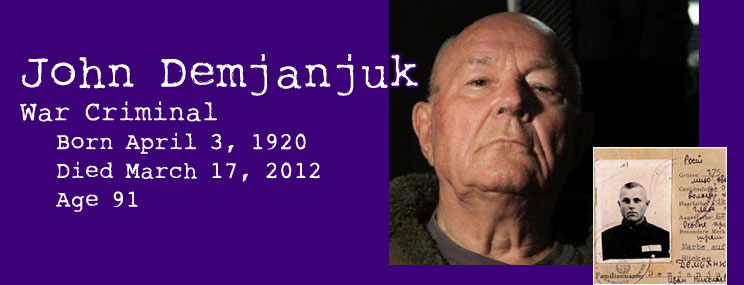 |
||||||||||||||
In the end he wasn't Ivan Marchenko, the infamous Ivan the Terrible, the murderous bastard who was the Nazis' pride of the Treblinka and Sobibor extermination camps. And no conviction ever stuck to Ivan (John) Demjanjuk, a retired auto worker who lived in Cleveland, Ohio. He went to his grave considered presumed innocent by the courts in Israel and Germany. Much of the evidence that convicted him in Israel in 1986 was manufactured by the Soviet Union's KGB, and later the United States Department of Justice was as unscrupulous as the USSR had been. Too bad, because he most likely was employed by the SS as a guard at the Trawniki Training Camp, the Sobibor and Majdanek death camps (all in Poland), and the Flossenburg camp in Germany. He had years of freedom because of the mischief of others. Finally, in May of 2011, Demjanjuk was convicted as an accessory in the murder of almost 28,000 Jews. However, his conviction was under appeal; in Germany, under their law, Demjanjuk's death vacates his conviction, except as an historical fact. So he was not the Ivan the Terrible, but he was a terrible excuse for a human. Sometimes we can forgive those who do bad, but we cannot allow those who would participate in such evil to go unpunished, regardless how long or how far we must go to bring the Ivan Demjanjuks to task. He was worth two points as an AO Deadpool pick for Allen Kirshner, Buford, Dannyb, JD and Kathi. To the rest of us, he was worth nothing. Total: 2. — Bill Schenley |
||||||||||||||
 |
||||||||||||||
The redoubtable Charlene. Thanks, Charlene. Again and again. This one is marvelous. * * * When news broke of the death of Pope Shenouda III of Alexandria, one question was on everybody's lips: Who the hell is Pope Shenouda III of Alexandria? Ridiculous, isn't it? There he was, the Patriarch of Alexandria, Archbishop of Cairo, Pope of the Coptic Orthodox Church — and he'd been pope for 40 years, mind you — and almost nobody in the West knew he existed. Meanwhile, that German blowhard gets all the press. Shenouda must have been pissed. Then again, if he had been more famous in the West, his stylin' coiffure might have got more press than he did.
Anyway, Pope Shenouda, who from all accounts was an excellent man beloved by his flock, was entrusted with the thoroughly thankless task of shepherding the Coptic Church. I say "thankless" because although the Coptic Church is officially recognized by whoever's running Egypt this afternoon, many Egyptians don't like the idea of a Christian denomination even existing in the country, let alone claiming ten percent of the population as members. Egyptian Christians of all stripes are regularly beaten, raped and even killed by Islamist and ultra-nationalist groups. Surviving forty years as a parishioner in that environment is difficult; forty years as the leader was amazing. Also amazing is the fact that Pope Shenouda III died of natural causes in his bed at the age of 88. The one-two punch for him was liver and kidney disease, but the one-two punch on the AO Deadpool came from DDT and WEP, with five points for Shenouda's age and two for the duet. Total: 8. — Charlene |
||||||||||||||
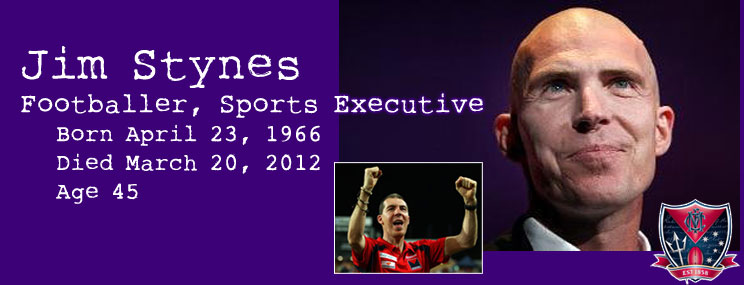 |
||||||||||||||
Gerard Tierney comes through again, and does a fabulous job of explaining sports from a far-off land. Thanks, GT. Much appreciated. * * * When four upstart owners announced their intention to start a new sports league, few would have predicted they could compete on an equal footing with an established monolith that, while only recently having come into its own, would within a decade overtake Major League Baseball as the true national pastime. But within the same span of years, the upstarts would officially be recognized as equals, a status which most observers, at least in their hearts, considered an understatement. To compete meant to innovate. The new league emphasized the passing game as never before, introducing a wide-open style of play accompanied by a space-age array of shifting formations. One of the most lasting innovations, however, was actually a throwback to the game's century-old roots. In 1964, Hungarian-born Pete Gogolak of the Buffalo Bills became professional football's first "soccer style" placekicker, opening the door to a wave of European imports: Englishman Bobby Howfield. Future Hall of Famer Jan Stenerud from Norway. And a "tall, skinny lad" from Dublin named Jim Stynes. When Stynes, the highest profile product of the so-called Irish Experiment, was recruited, few Americans had even heard of Gaelic football. Yet AFL owners, noting the similarities between their sport and the Irish game, saw it as an untapped pool of potential talent. While Stynes immediately captured the Melbourne reserves best and fairest, he was also involved in an embarrassing event which ... what's that? He played for the Australian Football League??? Oh, for Christ's sake. DDT, Gerard Tierney and Mo score three goals (18 points) for the hit, one behind (1 point) for the trio. Total: 19. — Gerard Tierney
|
||||||||||||||
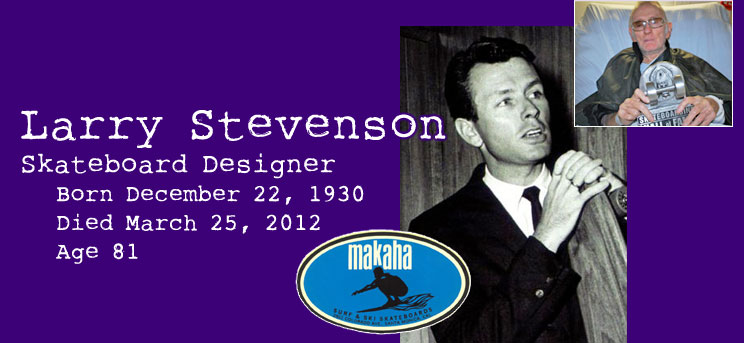 |
||||||||||||||
Oh, Bill is getting devious! Clever man. * * * Larry Stevenson, who died in March was the inventor of the kick-tail skateboard, which made most of today's skateboarding tricks possible. ˙sıɥʇ oʇ ɹɐlıɯıs sʞɔıɹʇ lɐɹıds op oʇ sɹǝpɹɐoqǝʇɐʞs sʍollɐ ʇɐɥʇ pɹɐoq ǝɥʇ ɟo ɹɐǝɹ ǝɥʇ uo ǝʌɹnɔ ǝlʇʇıl ʇɐɥʇ sı lıɐʇ-ʞɔıʞ ǝɥʇ Prior to Stevenson, a skateboard was just a piece of wood with four roller-skating wheels. He essentially revolutionized the sport by turning a skateboard into a mini-surfboard with clay wheels, and skateboarders could op sdoolǝp-dool lıʇun ɹıǝɥʇ sʇɹɐǝɥ ǝɹǝʍ ʇuǝʇuoɔ. Last year Bob Feigel, who used to work for Larry Stevenson, posted on Facebook about the late Mr. Stevenson's poor health ... Okay, I'm a shameless fucking deadpool player and I grabbed that bit of information, hopped on my Makaha skateboard, pıp ɐ ʍǝɟ ʎʇɟıu sʞɔıɹʇ puɐ sɐʍ ǝuoƃ ǝʞıl ɐ ʎpoq ɹǝɥɔʇɐus uı ǝɥʇ ʇɥƃıu. I get five points for the hit and five more for the solo. Total: 10. — Bill Schenley |
||||||||||||||
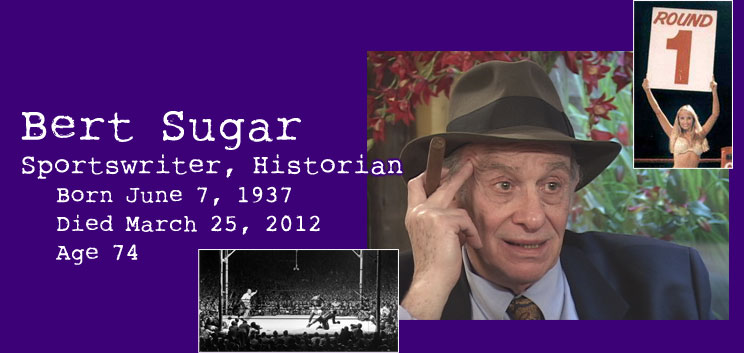 |
||||||||||||||
DDT tells me that all the "S's" on his list have died already this year. I thought we should celebrate by having him write one of them. (Thanks ever so much for letting me twist your arm.) * * * The recent death of the veteran author, historian and raconteur Bert Sugar deprived the boxing world of one of its most flamboyant and iconic characters. Sugar spent more than forty years covering boxing, and during that time he acquired an almost unrivaled knowledge of the sport. This knowledge was shared via Sugar's prodigious output during his career: He wrote more than eighty books, produced countless articles, and appeared frequently on television and radio, always ready to offer his opinion on any given subject with apparent ease. Herbert Randolph Sugar, born and raised in Washington DC, was an educated man, with degrees in business and law from the University of Michigan. He worked in advertising for a full decade before changing course in 1969 when, having already covered some title fights for his local newspaper, he purchased the magazine Boxing Illustrated and devoted the rest of his career to writing and talking about the sport he loved. Bert Sugar was one of the most recognizable faces on the boxing scene. Usually attired in a blazer and striped trousers, he was almost always pictured wearing his trademark fedora hat, and with a large cigar clamped between his teeth. In the rare photos of Sugar when he wasn't sporting either of these items of apparel, he looked wholly different, almost more vulnerable in the absence of the props that defined him. Sugar's brash personality set him apart almost as much as his flamboyant appearance. He spoke with a disarming candour and frankness about boxing and boxers. His forthright views were backed up by such a thorough understanding of the sport that it was rare for Sugar to ever finish second place in an argument. Some of those who knew him wrote upon his death that, behind closed doors, Sugar was much more modest and taciturn than many may have suspected. Such was Sugar's legendary status within the world of boxing that it is easy to forget he found the time to write books on other sports, such as baseball and wrestling, as well as a biography of Harry Houdini. Sugar suffered from health problems in his later years, culminating in a diagnosis of lung cancer. He was determined to overcome the illness, and even after he nearly died in November 2011 when he was hospitalized with pneumonia, he was writing articles again within days, lamenting the fact that his crumbling respiratory system meant it was no longer feasible for him to smoke cigars. Sugar continued to insist he would beat lung cancer and even on this point, he couldn't be proved wrong: While he was still fighting the disease, he was felled by a cardiac arrest. — DDT
|
||||||||||||||
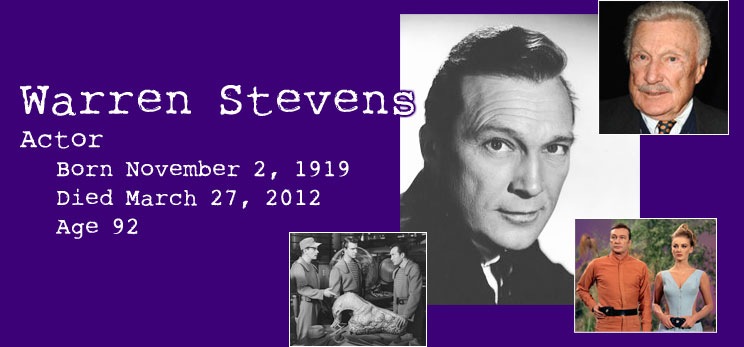 |
||||||||||||||
Matt Hubbard uses the "n" word, and I let him. Wonderful update. Far better than any character actor update I've ever done. It's long, so I'll give the facts up front: B&T's Characters get 7 points, 2 for the hit and 5 for the solo. * * * There was something about Warren Stevens that casting directors liked. There was also something about Warren Stevens that casting directors didn't like. Those two sentences define his career. I have no personal inside knowledge about Warren Stevens, but looking at his credits on imdb.com, he was a good, reliable actor who did what was asked of him and didn't make a fuss. Look at how many TV shows on his C.V. hired him twice or more to play different roles: Checkmate, Surfside Six, Wagon Train, Hawaiian Eye, Route 66, Gunsmoke, 77 Sunset Strip, Have Gun — Will Travel, The Richard Boone Show, Kraft Suspense Theater, Bob Hope's Chrysler Theater, The Donna Reed Show, Combat!, Voyage to the Bottom of the Sea, Bonanza, Mission: Impossible, Ironside ... the list goes on and on. A guy who's a pain in the ass doesn't get cast 163 times and doesn't get asked back to play another role on dozens of TV shows. He learned his lines, he hit his marks, he didn't make life hell for the regular cast or the crew. But here's what he didn't have: One successful show where he played the same character multiple times. Technically, he did have a show called Bracken's World, about a movie studio where the boss was a voice on the intercom or phone but was never seen. He played John Bracken in the first season. When the producers finally felt that gimmick was played out and let Bracken be seen, the role was given to Leslie Nielsen, someone that TV executives thought the audience could actually like. Leslie Nielsen and Warren Stevens have several similarities in their careers. The first and most obvious is co-starring in Forbidden Planet. Nielsen's character is the hero and gets the girl. Stevens' character eats from the forbidden tree of knowledge and dies. Actually, in the movie, the tree was played by a helmet that turned the wearer into a brainiac. Stevens gets the all-important information that allows the hero to destroy the beast, but he doesn't kill the beast and he doesn't get to snog Anne Francis. The hot girls don't snog brainiacs. I know this from first-hand experience. This is the story of Stevens' life, or at least his life on screen. Warren Stevens was a good-looking guy, but casting directors decided early on he was the good-looking but not likeable guy. Wikipedia calls his character in The Barefoot Contessa "emotionally stunted." He's the leader of the cold unfeeling aliens who hijack the Enterprise and try to take it to another galaxy on Star Trek, the episode famously summed up by Franklin Ajaye's line "The nigger's a cube, Captain." Stevens had a long, successful career, so if it bothered him playing cold, calculating creeps for several decades, he kept his unhappiness to himself. But, every once in a while, you have to wonder if he thought about all the other guys he met on the set of Forbidden Planet and their somewhat sunnier career paths. Leslie Nielsen worked a lot, stole a role from Stevens and then got massively lucky late in his career with Airplane! and Police Squad/Naked Gun. Jack Kelly was on Maverick, Richard Anderson on The Six Million Dollar Man, Earl Holliman had a great career in westerns and then was on Police Woman with Angie Dickinson. Would it have killed the suits in Hollywood to let Warren Stevens smile every once in a while, to crack a funny joke or have a fabulous babe drape her arms around him and give him a big sloppy kiss? My opinion is that it wouldn't have killed them, but now that Stevens is gone, we will never know. He played the thankless roles, and I think it's long past time someone thanked him. Nice work, buddy, from one emotionally stunted brainiac to another. — Matthew Hubbard |
||||||||||||||
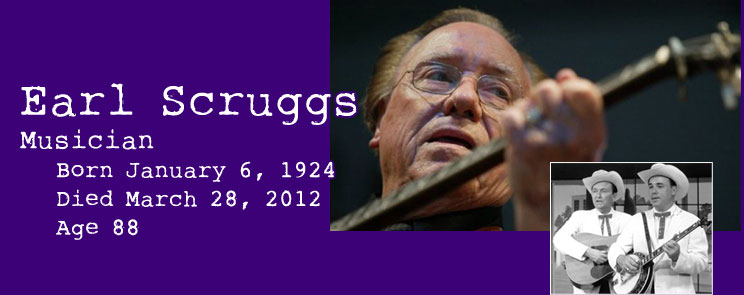 |
||||||||||||||
One of the most remembered TV themes is "The Ballad of Jed Clampett," featuring the three-finger banjo work of Earl Scruggs. Earl and his musical partner Lester Flatt would sell out Carnegie Hall, much to the disdain of Dorothy Kilgallen, who called them "the hicks from the sticks." Earl was the youngest of five children. He lost his father at the age of four, which is when he started playing the banjo. At the age of ten, after playing only the tune "Ruben" for a week, Scruggs realized he had been using three fingers instead of the usual two. Scruggs related later that it shocked him because he'd had the banjo tuned in D all week and had not even tried another song. However, when he did change the tuning, he was able to play other tunes on the banjo with the three-finger method. This method of playing would set him apart from other banjo players for the rest of his life, and his style of playing will continue to inspire generations. It was in 1945, when Earl was 21, that he and Lester Flatt joined Bill Monroe for one of Bill's greatest lineups. By 1949 they had formed their own band, the Foggy Mountain Boys, and had changed one of Monroe's tunes to "Foggy Mountain Breakdown," a song later used in the film "Bonnie and Clyde." Flatt and Scruggs would stay together for 20 years. Earl's biggest asset and fan was his wife Louise, who he met at a Grand Ole Opry appearance in 1946. They married in 1948 and Louise became Earl's manager; she was the first female manager in country music. Scruggs maintained that his career would have never taken off without his wife's help. (Louise died in 2006.) The next phase would be the Earl Scruggs Review, a less traditional group featuring Earl's sons Gary, Randy and Steve. Earl Scruggs, over the course of his lengthy career, played with many notable musicians from other genres: Bob Dylan, Arlo Guthrie, Joan Baez, Linda Ronstadt, Elton John, Tom T. Hall, the Byrds, Ravi Shankar and King Curtis were just a few. Scruggs was also instrumental in getting musicians like Roy Acuff and Mother Maybelle Carter, who were considered political conservatives, to participate in the Nitty Gritty Dirt Band's iconic album "Will The Circle Be Unbroken." Flatt and Scruggs went into the Country Music Hall of Fame in 1985 and were charter inductees in the Bluegrass Hall of Fame. Louise was also inducted into the Bluegrass HoF in 2010, and I was in the audience at the IBMA awards for the tribute. "Foggy Mountain Breakdown" is among the music listings in the Library of Congress. Busgal, johnssbowers and RH Draney score a trio for one of the most important instrumentalists of the 20th century. That's five points for the hit and a bonus point for each. Total: 6. — Busgal |
||||||||||||||

